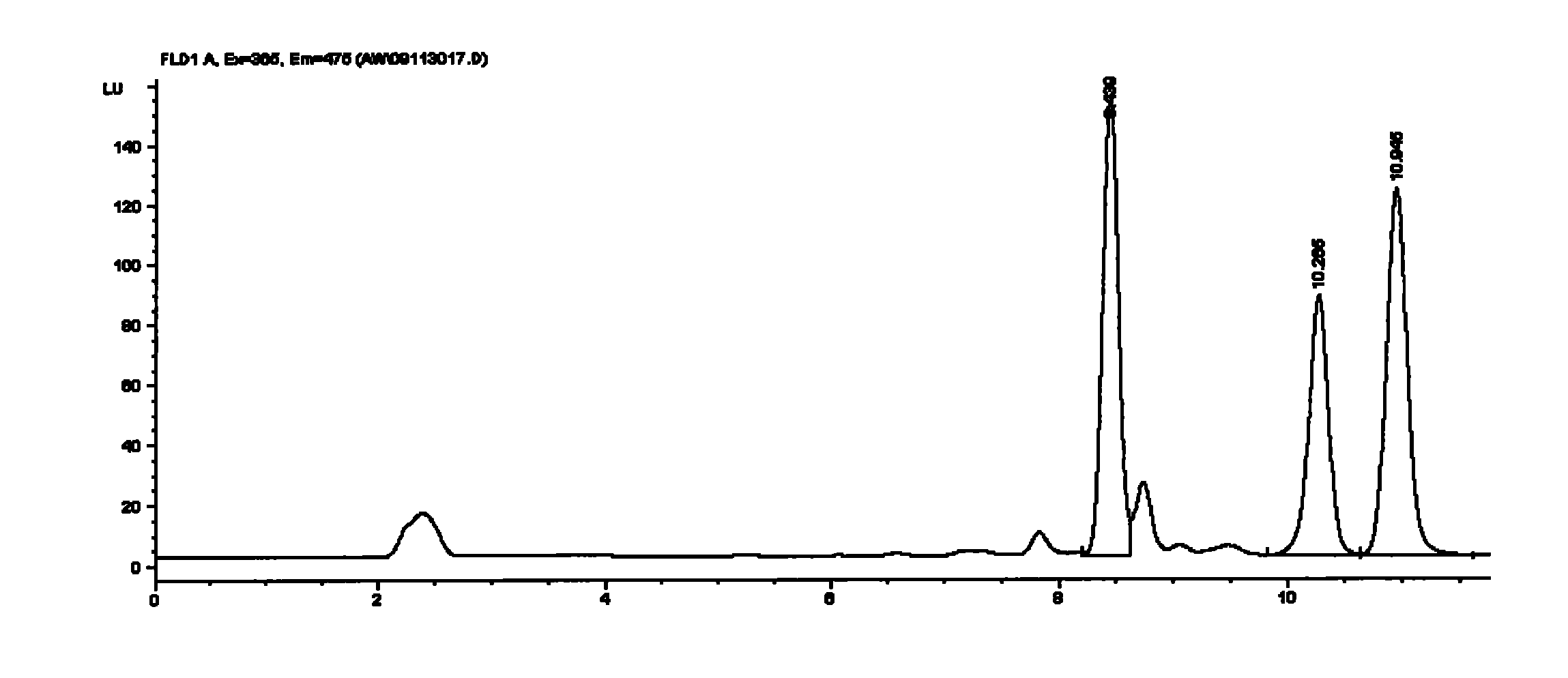Method for detecting avermectins pesticide multi-residues in cereal agricultural products
A technology with many residues of abamectins and pesticides, applied in measuring devices, instruments, fluorescence/phosphorescence, etc., can solve the problem of very little research on abamectins pesticide residues
- Summary
- Abstract
- Description
- Claims
- Application Information
AI Technical Summary
Problems solved by technology
Method used
Image
Examples
Embodiment 1
[0038]Example 1: Detection of multiple residues of abamectin pesticides in rice
[0039] The first step: sample pretreatment:
[0040] After the rice sample is crushed with a grinder, pass through a 100-mesh sieve (the sample cannot be measured immediately and stored in a -20°C refrigerator). Weigh 20 g of the crushed sample and place it in a 100 mL flat-bottomed glass bottle, add 50 mL of acetonitrile, and the sample is heated at 14000 r / min After homogenizing with a high-speed homogenizer for 2 minutes, place it in a microwave-assisted extraction device for 20 minutes;
[0041] After standing still for 1 hour, filter the extracted sample filter paper into a 100mL stoppered measuring cylinder filled with about 5g of sodium chloride, shake the filtrate vigorously for 5 minutes and then let it stand for 30 minutes, and use the salting-out effect to separate the organic phase;
[0042] Draw 10 mL of the extract from the organic layer and transfer it to a glass test tube, then d...
Embodiment 2
[0061] Example 2: Detection of Abamectin Pesticide Residues in Wheat
[0062] The first step: sample pretreatment:
[0063] After the wheat sample is pulverized with a grinder, pass through a 100-mesh sieve (the sample cannot be measured immediately and stored in a -20°C refrigerator), weigh 30 g of the pulverized sample and place it in a 100 mL flat-bottomed glass bottle, add 90 mL of acetonitrile, and the sample is heated at 14000 r / After homogenizing for 2 minutes with a high-speed homogenizer, place it in a microwave-assisted extraction device for 20 minutes;
[0064] After standing still for 1 hour, filter the extracted sample filter paper into a 100mL stoppered measuring cylinder filled with about 5g of sodium chloride, shake the filtrate vigorously for 5 minutes and then let it stand for 30 minutes, and use the salting-out effect to separate the organic phase;
[0065] Draw 20 mL of the extract from the organic layer and transfer it to a glass test tube, then dry it w...
Embodiment 3
[0084] Example 3: Detection of multiple residues of abamectin pesticides in corn
[0085] The first step: sample pretreatment:
[0086] After the corn sample is pulverized by a grinder, pass through a 100-mesh sieve (if the sample cannot be measured immediately, store it in a -20°C refrigerator), weigh 10 g of the crushed sample and place it in a 100 mL flat-bottomed glass bottle, add 30 mL of acetonitrile, and the sample is stored at 14000 r / After homogenizing for 2 minutes with a high-speed homogenizer, place it in a microwave-assisted extraction device for 15-20 minutes;
[0087] After standing still for 1 hour, filter the extracted sample filter paper into a 100mL stoppered measuring cylinder filled with about 5g of sodium chloride, shake the filtrate vigorously for 5 minutes and then let it stand for 30 minutes, and use the salting-out effect to separate the organic phase;
[0088] Draw 10 mL of the extract from the organic layer and transfer it to a glass test tube, th...
PUM
 Login to View More
Login to View More Abstract
Description
Claims
Application Information
 Login to View More
Login to View More - R&D
- Intellectual Property
- Life Sciences
- Materials
- Tech Scout
- Unparalleled Data Quality
- Higher Quality Content
- 60% Fewer Hallucinations
Browse by: Latest US Patents, China's latest patents, Technical Efficacy Thesaurus, Application Domain, Technology Topic, Popular Technical Reports.
© 2025 PatSnap. All rights reserved.Legal|Privacy policy|Modern Slavery Act Transparency Statement|Sitemap|About US| Contact US: help@patsnap.com



